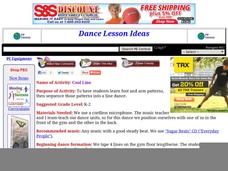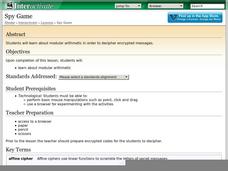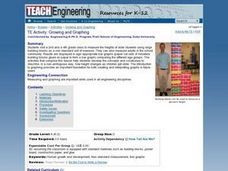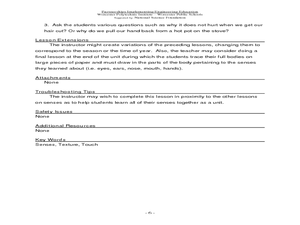Curated OER
Cool Line
This dance activity focuses on lots of arm movements. Arm circles, raise-the-roof, swinging arms, and clapping are the main arm movements. There is movement stepping right and stepping left as well as steps forward and steps backward. It...
Curated OER
Try Tessellation
Most middle schoolers probably feel that quilting is at best an activity left to their grandmothers. This lesson uses the Zome modeling system to get them to realize how shapes in quilting are really tessellations and repeating patterns....
Curated OER
Clifford Goes to School and So Do We!
Students use the story, "Clifford Goes to School," to investigate the value of rules as a means of keeping them safe. Following step-by step directions, the rules are placed on patterns and which are worn home.
Curated OER
Star Drill
The star drill is set up to practice throwing and catching a football. The path of whom to throw to in this group of five players is to follow the pattern of drawing a star. The players practice their skills and as they get better,...
Curated OER
Mean and Standard Deviation
Get two activities with one lesson. The first lesson, is appropriate for grades 6-12 and takes about 20 minutes. It introduces the concept of measures of central tendency, primarily the mean, and discusses its uses as well as its...
Curated OER
Lines of Symmetry
Young scholars practice dance to divide the space or body shape into equal sections to create symmetry in dance. In this symmetry lesson, students practice symmetrical and asymmetrical movements in dance. Young scholars participate in...
Curated OER
This Land is Your Land Shaker Routine
Shake it up! Give each dancer two hand-held shakers of any kind. If your class doesn't have any shakers, do a project and make your own. Small containers with lids, some rice or dried beans, and glue or tape to seal the lids shut. Teach...
Curated OER
A Sample of What?
Students are introduced to the connection between women and the textile industry. Using primary source documents, they complete a handout on how gender roles have changed over the years. They examine a sampler which is connected to the...
Curated OER
Animal Coverings
Students compare and contrast the types of coverings found on animals. They identify a wide variety of animals in a museum room. They classify animals based on their coverings as well.
Shodor Education Foundation
Spy Game
Turn students into detectives as they decipher encrypted messages. Introduce your class to modular arithmetic and have a little fun encrypting and decoding secret messages. The activity does not hit many content standards, but would be...
Curated OER
Graphs and Functions
Use this series of activities to introduce learners to graphing functions. They graph both linear and quadratic equations by hand and with a Graph Sketcher Tool. Several imbedded links and handouts are included in the lesson.
Curated OER
Graphing the Population Explosion of Weeds
Students are introduced to the seed cycle and draw the specific steps. In groups, they identify the human barriers to the spreading of weeds. After calculating the rate of spreading of the Yellowstar Thistle, they create graphs to see a...
Curated OER
Forces and Motion
Fourth graders study straight line motion and the forces that affect motion, including the terms force, gravity, and speed. They determine that gravity, weight, and other forces have an effect on speed and motion.
Curated OER
Reading & Using a Nutrition Label
Students discover the importance of healthy eating. Using food nutrition labels, they read and examine the nutritional value. Students collect the data on a spreadsheet and create a graph. They analyze the media influences on product...
Curated OER
Growing and Graphing
Students visit a 2nd and a 4th grade class to measure the heights of older students using large building blocks as a non-standard unit of measure. They can also measure adults in the school community. Results are displayed in...
Curated OER
Let's Trade
Second graders engage in a instructional activity which focuses on adding two-digit numbers and the regrouping process. They identify when the regrouping process is necessary and make appropriate "trades" to complete an addition problem.
Curated OER
How Do We Spend, Save, and Donate?: Penny Drive
Students explore the power of money. In this philanthropy lesson, students investigate how money is used in society. Students record data regarding money patterns on graphic organizers.
Curated OER
Engineering the Senses
Students become aware of texture and the sense of touch. In this senses lesson, students become aware of their dominant hand. Students draw pictures using texture. Students describe a texture of an item in a mystery bag.
Curated OER
Michigan Virtual Field Trip
Students analyze data from a virtual field trip to Michigan. They conduct Internet research on mileage and travel time between cities, calculate and compare fuel costs, and research and calculate lodging, activities, and meal costs.
Curated OER
TE Lesson: What to Wear? What to Drink? Weather Patterns and Climatic Regions
Young scholars examine how climate affects lifestyle, clothing choices, food, and water sources. They explore climatic regions such as tropical, desert, coastal, and alpine situations. They look at the longitude and latitude, land...
Curated OER
Dolls in Tunics & Teddies in Togas
Young scholars identify the basic components of male and female Roman
costume, both for children and adults and also, the major social ranks of Imperial Rome and the dress reserved for each gender and rank. They also identify some of the...
Curated OER
Who Has Seen the Wind?
Students investigate the characteristics of wind. For this weather lesson, students use poetry and van Gogh's paintings to discuss the movement of wind. Students are introduced to the Beaufort Scale and use the tool to measure the wind...
Curated OER
4-H Clothing and Textiles Leader's Page
This activity could be used in a home economics class to teach students about sewing and clothing. Using this 10 question worksheet, learners explore the function of a sewing machine, and plan a project.
Perkins School for the Blind
Figure Eight Walking
Walking in a straight line is one thing. Walking while trying to shift your weight from side to side to maintain balance is another challenge altogether. Learners with visual impairments practice walking in a figure eight. Cones are set...

























